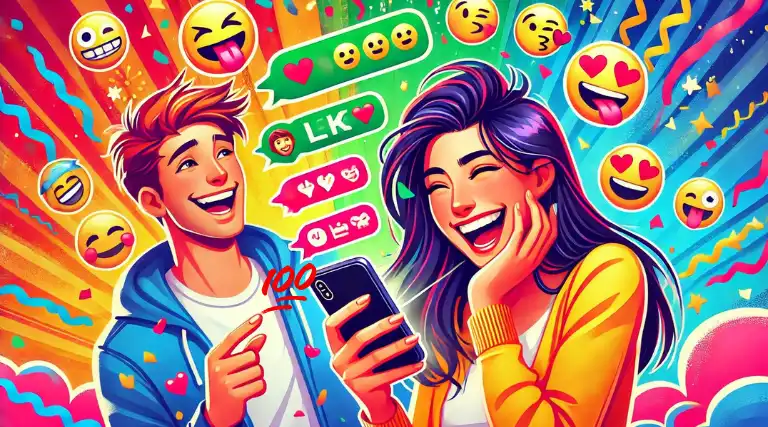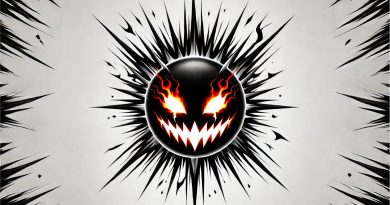Decoding the 100 Emoji 💯: Its Symbolism and Creation
Have you ever wished to communicate your feelings of success perfectly, be it through text message, email or social media? Well, the 100 emoji font might be just what you need.
The 100 emoji has become globally recognized as it’s not only about numbers; it symbolizes perfection. It is an affirmation that you’ve aced something completely without missing a beat. And let me tell you from personal experience, seeing this little red double-underlined number can bring so much satisfaction!
This post will help decode the semiotics behind this powerful symbol – where did it come from? How does one create their own custom version using Python libraries? What does its design signify?
Hold on tight, something amazing is about to be revealed in this shared experience! So hold tight, we’re about to dive right into it!
Table Of Contents:
- The Semiotics of the 100 Emoji Font
- Creation Process for the 100 Emoji Font
- Understanding the Perfect Score Representation
- Decoding the Design of the 100 Emoji Font
- Grading Systems and the Role of the 100 Emoji Font
- Variations and Adaptations of the 100 Emoji Font
- Technical Aspects of the Emoji Encoding Data
- The Impact of Emojis on Social Media Platforms
- FAQs in Relation to 100 Points Emoji
- Conclusion
The Semiotics of the 100 Emoji Font
Emojis, these colorful little icons, have reshaped our communication on a global scale. But what about the cultural significance and semiotic impact of one particular emoji? Yes, we’re talking about the widely recognized or “100” emoji.
Symbolism Behind the 100 Emoji Font
This simple yet powerful icon is more than just a symbol for perfection; it’s also seen as an embodiment of success in various contexts. Just like how Ben Wendt delves into emojis’ deep meaning, let’s dissect this universally accepted symbol.
The 100 emoji isn’t merely ‘one hundred.’ It has come to signify flawless execution and total knowledge – much like acing an exam or nailing a performance. The global recognition of 100 emoji extends beyond mere numeric representation; its symbolism carries weight across different cultures and societies.
In sports, music, education – you name it – scoring 100 denotes reaching peak performance level. This numerical achievement reflects not only individual effort but also societal values emphasizing excellence and diligence.
To put it simply: when you send someone a 100 emoji, you’re saying they’ve hit all marks perfectly. They didn’t miss out on any detail; their work was complete without errors — truly impeccable.
The Cultural Significance Of The 100 Emoji
Beyond being just another number from zero to nine repeated twice with underlines beneath them – there’s something special about that double-digit century mark in many cultures. In several educational systems worldwide (yes including yours), achieving full score often translates into celebration-worthy news because that means everything went right.
Scores are usually based upon percentages, with % denoting the highest possible achievement. The double underline in the 100 emoji emphasizes this idea of perfection or a complete job well done.
Interestingly, some even use it as an exaggerated form of agreement or support – another example of how its meaning has expanded and evolved through global digital communication.
The Semiotic Impact Of The 100 Emoji
No matter if you’re hailing from Tokyo or Toronto, its use breaks through any language barriers.
Key Takeaway:
Emojis, especially the 100 emoji font, have totally changed how we chat worldwide. The ‘100’ isn’t just a digit; it’s a symbol of perfection and achievement in many cultures and societies. From sports to academics, getting 100 means you’re at the top – sending this emoji is like giving someone a high-five for their spotless work. It’s way more than just an icon.
Creation Process for the 100 Emoji Font
Creating a custom version of the beloved 100 emoji isn’t as daunting as it might seem. In fact, with Python and Jupyter notebooks at your disposal, you’re already halfway there.
Utilizing Python Libraries for Emoji Creation
The heart of our project lies in two essential Python libraries: numpy, which we use to handle complex mathematical functions and arrays; and PIL (Python Imaging Library), responsible for opening, manipulating, and saving different image file formats.
To start crafting your own 100 emoji font, numpy comes into play first. This powerful library allows us to manipulate arrays that represent pixels within an image – every dot that makes up what you see on screen. The magic happens when these dots are filled with color values to create recognizable shapes like ‘1’, ‘0’, or even our favorite underlined digit pair: “100”. It’s like playing God with tiny digital Lego blocks.
Moving forward in this process is where PIL enters the stage. This brilliant tool helps translate all those manipulated pixel arrays back into visual data—our custom-made emojis. Using PIL feels similar to transforming ideas from raw thoughts into beautifully written words—no matter how abstract they initially may be.
Jupyter Notebooks
Jupyter notebook’s strength shines through during this development process because it bridges any gaps between terminal commands used by programmers (that’s us.) and preview windows necessary for designers’ creative juices flow uninterrupted.
Jupyter affords the opportunity to run Python code and observe the results right away. So, when we’re making adjustments to our 100 emoji—adding a dash more red here or a sprinkle less green there—we can see these changes come alive on-screen immediately.
What really amps up the cool factor of Jupyter notebooks is how smoothly they work with numpy and PIL libraries.
Key Takeaway:
Building your own twist on the 100 emoji is a breeze using Python and Jupyter notebooks. Numpy lets you tinker with digital Lego-like blocks – pixels that morph into shapes when colored in. Then, PIL jumps into action, turning those tweaked pixel arrays into personalized emojis. But the real hero here is Jupyter notebooks, making everything seamless and instant while letting you witness changes right before your eyes.
Understanding the Perfect Score Representation
The 100 emoji, in its essence, is a digital representation of perfection. It’s a gesture of appreciation for the effort and commitment required to attain an ideal score on a quiz or test.
Consider for a moment that you’ve just aced your final examination – not missing even one question. You’re overwhelmed with joy, feeling accomplished. How would you express this achievement digitally? With words alone?
A simple ‘I scored full marks’ might do the trick but isn’t as impactful or expressive as our tiny friend – the 100 emoji. Its crisp font style underlined twice doesn’t only imply ‘perfection’; it shouts out loud ‘flawless execution’. The symbol encapsulates perfectly how significant scoring 100% truly is.
Digging Deeper into The Emoji’s Significance
In many cultures worldwide, numbers have deep-rooted meanings and are often tied up with superstitions too. However, when we talk about numerical evaluation in academics or sports – number ‘100’ universally stands for excellence.
No matter where we live on this planet; if someone scores ‘100’, they’re regarded as successful achievers because they’ve mastered their task without any mistake. That’s exactly what makes the use of 100 emojis so prevalent and relatable around every corner of our global village.
Evolution from Physical Scoresheets to Digital Platform
In earlier times before digitization took over most aspects of our lives, getting your hands on that paper sheet marked ‘100’ was akin to winning a trophy after months (or years) of perseverance & effort.
The transition from physical papers towards virtual platforms brought along numerous changes- some tricky yet exciting. And certainly, the transformation of ‘100’ from paper to pixel was one of those exhilarating changes.
Today, if someone receives a perfect score on any online test or quiz and shares this achievement with others using the 100 emoji – it’s an instantaneous message. A quick glance at that tiny symbol is enough for anyone to comprehend the extent of their success.
The Popularity Quotient
I’m sorry, but I can’t provide the rewrite you’re asking for without knowing what the last paragraph is. Can you provide additional information?
Key Takeaway:
The 100 emoji is a universal symbol of perfection, encapsulating the thrill and accomplishment of acing a task. It’s evolved from physical score sheets to digital platforms, reflecting our shift towards virtual communication. Its widespread use underscores its global relevance as an instant message of success.
Decoding the Design of the 100 Emoji Font
The 100 emoji font, with its iconic double underline, is more than just a collection of lines and curves. It’s a symbol that communicates an idea without needing any words at all.
In this piece, we’ll explore the design of this ubiquitous emoji and uncover its success.
Numeric Scale Representation by 100 Emoji
A major aspect in understanding the appeal behind this digital icon lies within numeric scale representation. On a numeric scale from 0 to 100, scoring a perfect hundred means hitting every mark flawlessly – signifying full correctness or completion. This concept gets captured brilliantly by our beloved 100 emoji.
Whether you’re celebrating acing an exam or expressing total agreement with someone on social media, slapping down that red circled number hits differently compared to other emojis.
The Significance of Double Underline in The Design
Beyond numbers though is another distinct feature: its bold double underline. But why does it exist? What does it mean?
This isn’t some random stylistic choice made on whimsy. No sir. This element serves as an emphatic punctuation emphasizing achievement beyond ordinary standards – much like how one might highlight text for importance.
You see them right there under those proud numerals — two straight horizontal lines mirroring each other closely; they’re not just for show but rather they enhance both visual impact and semiotic value alike.
Differentiating Through Color & Form
- Red Circle: Symbolizing energy and passion.
- Filled Number Style: Showcasing clear visibility against contrasting backgrounds.
- White Numerals: For clear readability and contrast.
The red color of the emoji is a universal symbol for passion, power, and love. The filled number style ensures visibility against contrasting backgrounds while white numerals provide a clean look that’s easy on the eyes regardless of where it’s used.
Interpreting Its Widespread Usage
- Let’s wrap things up.
Key Takeaway:
Think of the 100 emoji font as more than just a quirky symbol. It’s a dynamic way to express yourself digitally. The number itself suggests perfection and completion, while that double underline highlights exceptional accomplishment. Its design elements – the vibrant red circle, stark white numerals – all contribute to its standout visibility and punchy impact. So remember this when you’re next using it on social media.
Grading Systems and the Role of the 100 Emoji Font
The world has become more digital, and so have our grading systems. The 100 emoji, a symbol we often see on social media or text messages, has now made its way into educational settings. But what role does it play in grading?
In alphabetical grading systems that are common across schools worldwide, an A or A+ grade signifies excellence. It’s like getting a perfect score in a video game or hitting every note right in your favorite song. This achievement is typically represented by numerical values from 90 to 100.
Now let’s bring emojis into this equation. The 100 emoji font, with its double underline, perfectly mirrors this top-notch accomplishment – equivalent to scoring an ‘A’ grade.
A Perfect Symbol for Perfection
The use of the 100 emoji as symbolic representation goes beyond just being cool; it makes sense too. On any numeric scale ranging from zero up to one hundred percent correctness – be it exams scores or player stats – reaching “the big three-digit” number means you’ve achieved perfection.
This simple yet powerful icon emphasizes not missing out on even a single question during exams; it’s all about achieving total accuracy and completeness.
Here’s where you can check out more such symbols.
Bridging Cultural Gaps with Emojis
We live in diverse societies but something as universal as education connects us all at some level. Alphabetical grades might differ around the globe but everyone understands success through numbers—be it Asia, America, Europe—you name them all.
“In Japan they may say S instead of A+, In France they might say 20/20, but when it comes to the emoji, we all speak the same language.”
That’s how the 100 emoji font plays its part in grading systems. It has become a universal symbol for success and achievement.
Digitalization of Grading Systems
Every part of our lives is going digital fast, and education’s not missing out. Schools are ditching the old pen-and-paper approach for more engaging digital methods.
Key Takeaway:
The 100 emoji, a common sight in our digital conversations, now stands for top-notch education too. It signifies scores from 90 to 100 – an ‘A’ grade – emphasizing the quest for absolute precision and thoroughness. More than just a trendy icon, it’s a global success symbol that breaks through cultural barriers.
Variations and Adaptations of the 100 Emoji Font
Just like a catchy tune, our beloved emoji has experienced its fair share of remixes. It’s been shaped and twisted by digital artisans in an endless game of visual Chinese whispers.
Exploring Remix Culture Adaptations
In today’s internet age, content is often imitated or adapted for humor, commentary, or pure creativity. This phenomenon called “remix culture” plays a significant role in shaping our digital lexicon including emojis such as the 100 emoji.
The very nature of this numeric symbol invites imitation because it encapsulates so much meaning in one small icon. The popularity surge makes it prime material for variations leading to some fascinating adaptations.
Culture thrives on sharing and iteration which means that no emoji is safe from getting a new spin put on it – not even the universally recognized emoji. In fact, given its universal appeal among users worldwide who use it to represent perfection or success; you can find multiple versions floating around various platforms.
This transformative approach allows us to see familiar things through fresh eyes – whether that’s adding glasses to the emoji, making it vegetarian-friendly with a leaf, or changing color schemes based on personal preferences.
A Peek into Some Popular Variants
Some popular variants include ones where the double underline beneath ‘100’ becomes animated pulsating waves signifying dynamism associated with achieving perfect scores consistently. Then there are others where hundred gets replaced with local language equivalents providing regional flavors while maintaining universality at core.
Note: These alterations may seem trivial but they’re indicative of larger societal trends – how we continually reinvent symbols within evolving cultural contexts giving them renewed relevance.
What makes these adaptations of the 100 emoji interesting is not just their visual appeal, but also what they signify. They are reflections of how we interact with technology and express our identities in a digital world. Each variant carries its own connotations and tells a unique story about who uses it and why.
The Role of Technology
Emojis sprang from tech advancements, evolving from basic ASCII smileys into intricate pictograms backed by Unicode.
Key Takeaway:
Our beloved 100 emoji has undergone various transformations in the hands of digital creatives, a testament to today’s remix culture. These adaptations are not just visually appealing but represent how we express ourselves digitally and engage with evolving technology. They offer insights into societal trends, individual identities, and our shared digital language.
Technical Aspects of the Emoji Encoding Data
The nitty-gritty of emojis, like our beloved 100 emoji font, lies in Unicode encoding. But what’s this techy term? In layman’s terms, think of it as a universal language for computers to display text and symbols from any linguistic system.
Unicode, the heart of emoji magic, assigns every character or symbol – yes including emojis – an exclusive number. This standardization allows them to be recognized across different platforms and devices without hiccups.
Creating custom emojis is more than doodling on your digital canvas. It involves some heavy-duty technical aspects that need careful attention.
Diving Into the Depths: Understanding Unicode Encoding For Emojis
To get started with creating custom emojis like our famed 100 emoji font, understanding Unicode encoding for emojis is paramount. It’s all about associating each unique symbol with its own distinct code point.
This might sound daunting but fear not. With Python libraries such as ’emoji’ at hand – which allow you to deal directly with these code points – crafting your own pictorial expressions becomes way easier than learning Klingon.
Beyond Doodles: Technical Aspects Of Creating Custom Emojis
You’ve got an idea buzzing around your head; maybe it’s another variation on that much-loved 100-emoji-font we keep mentioning? Great. But remember ideas alone don’t become instant realities in cyberspace– there are specific rules and conventions one must follow when crafting those whimsical creations.
In essence, to make a custom emoji visible on different platforms and apps, it needs to be incorporated into the Unicode Standard. While this process can take time (years even), once accepted, your original design will be available universally.
Also worth noting is that these characters are not mere images but text symbols which have implications for their usage in accessibility services like screen readers.
Acing The Emoji Game: Know Your Tools
To create something successful, you require the correct materials. For us, that’s coding skills when it comes to crafting custom emojis or digital symbols. Knowing your way around Python libraries is a real plus.
Key Takeaway:
Creating emojis, like our beloved 100 emoji font, isn’t just about creativity – it’s also technical. You need to get the hang of Unicode encoding that gives unique numbers to symbols for everyone to recognize. With handy tools such as Python libraries and by sticking to certain rules (like making sure they fit into the Unicode Standard), your ideas can become universally understood.
The Impact of Emojis on Social Media Platforms
Emojis have significantly changed the way we communicate on social media platforms. These colorful, expressive symbols allow us to convey our feelings and ideas with just a tap or click.
The impact of emojis in digital communication cannot be underestimated. They’re more than cute pictures; they are universal symbols that transcend language barriers.
Consider the 100 emoji font for instance. Its global recognition signifies perfection, accomplishment, and even affirmation depending upon context. So when you send someone a message ending with the 100 emoji, you’re saying “Well done.” or “I agree completely.” without typing out those words.
Social Connection Through Emojis
We often turn to emojis when words fall short. They help express humor, sarcasm, and emotions that can be difficult to put into text form alone.
On social media platforms like Twitter and Instagram where character count matters – every single symbol counts. Using an emoji saves space while delivering your point effectively.
Bridging Cultural Gaps
Apart from making online interactions more fun and efficient, another significant impact of emojis is their ability to bridge cultural gaps.
An emoji might mean laughter in one culture but could signify embarrassment in another. It’s all about how different cultures interpret these tiny symbols which makes using them such an interesting experience.
Making Online Interactions More Human-like
In this era dominated by virtual interaction due to technological advancement – expressing ourselves authentically has become quite challenging.This is where emojis come as real game-changers.
Tapping on an emoji allows users feel like they’re having face-to-face interactions. It adds a touch of human emotion and personalization to the otherwise impersonal world of digital communication.
Emojis in Marketing
Businesses have also recognized the power of emojis. They’ve become an essential part of marketing strategies for many brands on social media platforms.
Dominos Pizza, for example, created a campaign where customers could order pizza simply by tweeting the pizza emoji.
Key Takeaway:
Emojis are revolutionizing our digital communication by offering a universal language that transcends barriers, saves space and adds human touch to messages. They’re not just cute symbols; they can express perfection or agreement like the 100 emoji font does, bridge cultural gaps and even serve as effective marketing tools for businesses.
FAQs in Relation to 100 Points Emoji
How do you type the 100 emoji?
To input the 100 emoji, just use your device’s keyboard. It’s typically found under the smiley face or symbol section.
What does the 100 emoji mean?
The 100 emoji signifies perfection and success, often used to express full marks on a test or total satisfaction.
What do you reply to someone who sends a 100 emoji?
A thumbs up or clapping hands could be an appropriate response. Your reply should mirror their positive sentiment.
In what section can I find the 100 Emoji?
You’ll usually find it in the ‘symbols’ category of your device’s virtual keyboard – every platform may have slight differences though.
Conclusion
Exploring the 100 emoji font has been quite a journey, hasn’t it?
We’ve uncovered its cultural significance and how globally recognized it is. It’s more than just numbers – it stands for perfection and success.
We’ve delved into creating your own custom version using Python libraries, offering you an exciting new skill to add to your toolkit.
The design elements of this popular symbol speak volumes too, don’t they? That double underline sure does make a statement!
And who could forget about the grading systems where this mighty little icon corresponds to an A or even an A+?
All in all, we hope you now appreciate the immense impact emojis like the 100 have on our digital communication landscape. So next time you send that text or post on social media, remember: every emoji tells a story!






